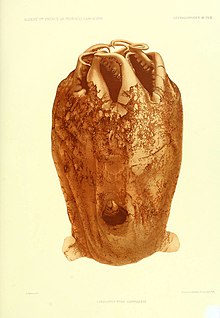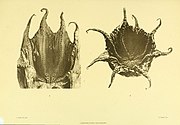| Opisthoteuthis grimaldii | |
|---|---|

| |
| Conservation status | |
 Data Deficient (IUCN 3.1) | |
| Scientific classification | |
| Domain: | Eukaryota |
| Kingdom: | Animalia |
| Phylum: | Mollusca |
| Class: | Cephalopoda |
| Order: | Octopoda |
| Family: | Opisthoteuthidae |
| Genus: | Opisthoteuthis |
| Species: | O. grimaldii |
| Binomial name | |
| Opisthoteuthis grimaldii Joubin, 1903 | |
| Synonyms | |
| |
Opisthoteuthis grimaldii is an octopus found near the Azores.
Opisthoteuthis grimaldii lives in the Northeast Atlantic Ocean from 1,135–2,287 m (3,724–7,503 ft) deep. This species lives far deeper than other Opisthoteuthis members in the Atlantic. The type specimen, upon which the species' description was based, was captured near Faial Island. The octopus has been found as far south as Namibian waters and as far north as British waters. In the early 1900s, many octopuses living all over the Atlantic and Indian oceans were classed as Opisthoteuthis grimaldii, but later scientists decided that only those specimens found in the Eastern Atlantic Ocean actually belonged to the species.
This octopus occupies in the bathyal zone, a deep area of the ocean where no sunlight reaches. Like many other cirrate octopuses, it lives on or just above the seafloor.
Opisthoteuthis grimaldii is anatomically very similar to Opisthoteuthis borealis, but the two species have differently structured digestive systems. It has also been confused with Opisthoteuthis massyae.
The octopus is only known from male specimens. The largest specimen was 250 mm (9.8 in) long, which is neither very large nor very small for an opisthoteuthid. Mature males have a few enlarged suckers on each arm; enlarged suckers are typical for males in the genus Opisthoteuthis. One potential female specimen has been found; however, it may not belong to the species.
The octopus has between 73 and 80 suckers on each arm. A fleshy web almost entirely covers O. grimaldii's arms. Like many cirrate octopuses, it doesn't have a radula.
References
- ^ Lyons, G.; Allcock, L. (2014). "Opisthoteuthis grimaldii". IUCN Red List of Threatened Species. 2014: e.T163304A995427. doi:10.2305/IUCN.UK.2014-3.RLTS.T163304A995427.en. Retrieved 20 November 2021.
- ^ "Opisthoteuthis grimaldii (Joubin, 1903)". World Register of Marine Species. Flanders Marine Institute.
- ^ Sánchez, P.; Villanueva, R.; Voss, N.A. (2002). "Systematics, distribution and biology of the cirrate octopods of the genus Opisthoteuthis (Mollusca, Cephalopoda) in the Atlantic Ocean, with description of two new species". Bulletin of Marine Science. 71 (2): 933-985. ISSN 0007-4977.
- ^ M.A. Collins; R. Villanueva (June 13, 2006). "Taxonomy, ecology and behaviour of the cirrate octopods.". In Gordon, J.D.M.; Atkinson, R.J.A.; Gibson, R.N. (eds.). Oceanography and Marine Biology: An Annual Review, Volume 44. CRC Press. p. 297. ISBN 9781420006391.
- ^ Jereb, P. (2005). Cephalopods of the World: An Annotated and Illustrated Catalogue of Cephalopod Species Known to Date · Volume 3. Food and Agriculture Organization of the United Nations. p. 256. ISBN 9789251079898.
- ^ Young, Richard E.; Vecchione, Michael (2003). "Opisthoteuthis grimaldii". Tree of Life Web Project.
| Taxon identifiers | |
|---|---|
| Opisthoteuthis grimaldii | |
